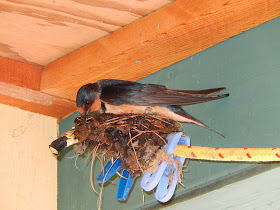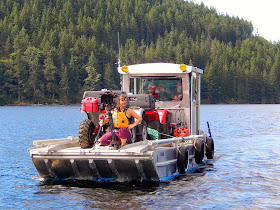
Over the years, as a result of composting, I've developed a plot of soil on our exposed granite cliff. The down side of using this area for gardening is limited access to water. It's a long haul with heavy buckets climbing four flights of stairs up from the lake.
Our good friend
John devised a rain water collection system using a 55-gallon plastic barrel and a tarp suspended from trees.

It's situated above my plot, so gravity provides enough pressure to water my plants. Summer gets pretty dry, so my one barrel didn't last long. John upgraded me to a
double-barreled watering system.

The plastic barrels will probably outlive me, but the tarp has been exposed to rain, sun, snow and wind for about ten years.
It needed to be replaced to make sure both of my barrels were filled before the last rains of the season.

We purchased a heavy duty woven polyethylene tarp that was UV resistant. Wayne had to resize a larger tarp because there were no longer any of the exact dimensions we had before. I purchased a grommet kit so we could place connection points that matched our tree attachment locations.
While the tarp had disintegrated over the years, the clothes line cording was still in good shape.

We untied the old tarp and put the new one up in it's place. With both of us working together it took over an hour. John probably completed the initial installation all by himself in half the time. But it made us feel good we could do it ourselves.
Thanks John for the design. Without it, we would have had a harder time of getting the new tarp in place. Sorry, it isn't as neat and tidy as yours, but the rain barrels are filling much better now. I guess that's what counts. -- Margy
 I was walking along the upper Eldred River and came upon this lovely red flower. It's the Red Columbine, also known scien- tifically as Aquilegia formosa.
I was walking along the upper Eldred River and came upon this lovely red flower. It's the Red Columbine, also known scien- tifically as Aquilegia formosa. The Columbine is a perennial plant, returning each spring with beautiful bright red blooms with yellow centers. Tall thin stems rise from the green leaves lying close to the ground. Look for Columbines in moist areas such as meadows, along lakes and streams (that's where I found mine), in clearings, and even on rocky slopes.
The Columbine is a perennial plant, returning each spring with beautiful bright red blooms with yellow centers. Tall thin stems rise from the green leaves lying close to the ground. Look for Columbines in moist areas such as meadows, along lakes and streams (that's where I found mine), in clearings, and even on rocky slopes. 






























